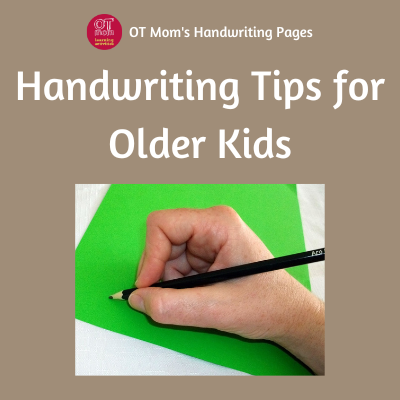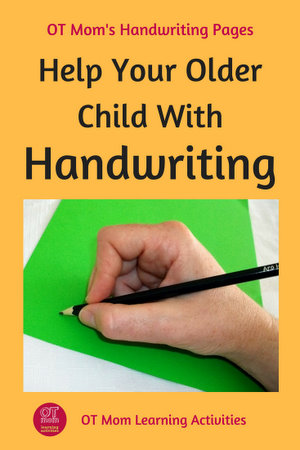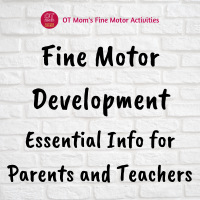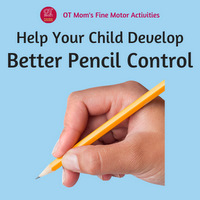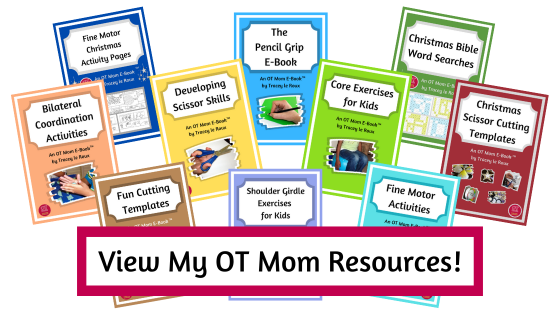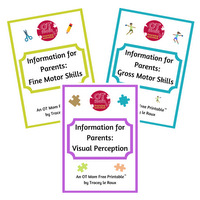- Home Page
- Handwriting for Kids
- Handwriting Tips for Older Kids
Improve Handwriting
Strategies To Help Older Kids Develop Skills
Many parents have asked how to improve handwriting skills in their older child or teenager.
Handwriting is a complex skill and there are many factors that can influence handwriting - underlying foundations that we can work on with younger children. However, if you are trying to help an older child or teenager to improve their handwriting, then we are usually looking for strategies that can be introduced and maintained by the child themselves.
If you feel your child's poor handwriting is affecting academic performance, please do seek an occupational therapy evaluation to help get to the bottom of the issues.
I sometimes link to products (#Ad) that are similar to those I use and love. If you do purchase something through my links, I will receive a small commission that helps support my site - thank you!
This page contains some suggestions that parents, teachers and kids can put into practice in the classroom or at home. There is not a one-size-fits-all solution and you and your child will need to work together to find a way forward to improve handwriting efficiency and neatness.
Strengthen Fine Motor Skills
Increasing hand strength and finger dexterity can help your older child get more control over the pencil (and hopefully improve handwriting as a result). Strengthening fine motor skills should also help improve endurance of writing tasks.
Encourage your older child to get involved with general household tasks that will use hand and finger muscles to help strengthen the hands - tasks like cutting with scissors, using a screwdriver, helping dad sort nails and screws in the garage, sewing and knitting...
Older kids and teens can still benefit from strengthening their hand muscles and getting better control over their fingers with focused activities.
But instead of doing the playful activities that younger kids do, call it a "hand exercise program".
There are some fine motor exercise ideas that may appeal to your older child on this page of my site.
Keep the suggested items at hand and encourage your child to get into
the habit of using them regularly before and during long writing tasks, for just 2-3 minutes at a time.
Try a Pencil Grip
I am not usually in favor of recommending the use of pencil grips without first addressing any underlying motor issues.
However, for older
kids, making use of a pencil grip could help reduce fatigue and prevent hand muscle
cramps, which may help to improve handwriting.
Let your child try different styles of pencil grips#Ad (also called pencil grippers) to see if any of those help reduce
fatigue. Surprisingly, the bigger grips are often the most comfortable.
 Using a pencil gripper to reduce fatigue
Using a pencil gripper to reduce fatigueRead my page about using pencil grips to find out more about the different kinds of pencil grips out there.
Strengthen the Upper Body
Encourage your child to build upper body strength through sports, climbing, swimming and targeted exercises. These will help strengthen and stabilize the shoulder muscles to free up the hand muscles for handwriting.
I have some ideas for shoulder exercises (free) on my site and in my e-book (aimed at younger kids, but older kids may still benefit) - have a look and see if there are any you can encourage your child to do.
If
your child gets tense and tired easily during handwriting, then try some focused shoulder or core exercises as a break.
Developing upper body strength or core strength may be just what your child needs to help improve handwriting!
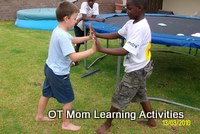 shoulder exercises may help
shoulder exercises may helpItalic Cursive Can Help Improve Handwriting
Some children really struggle to write (and to read) the loops of regular cursive handwriting. My own kids benefited from the Getty-Dubay handwriting books, which are italic. The "italic cursive" handwriting books helped all of my own children to develop flowing handwriting, which was much neater than their printed handwriting.
I recommend italic cursive especially for kids who struggle with fine motor and visual perceptual skills.
Italic Handwriting Book F#Ad is designed for use in Grade 5 for those who have used the earlier books. If your child requires slightly easier work to start with, then try Book E#Ad .
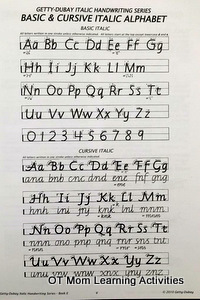 Italic writing
Italic writing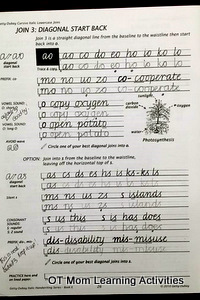 Book E sample
Book E sampleUnderstand And Practice Regular Cursive
If the italic cursive mentioned above is not for you, or your child's school prefers regular cursive, then understanding the basic cursive rules may help your child master neater handwriting, especially if your child has not had any formal cursive writing lessons.
Hop over to my friend Mary's page on cursive handwriting, read her helpful explanations of how it works, and download her free cursive practice worksheets!
View Cursive Writing Rules and Free Worksheets here! These are good for kids in grade school
If your teen has had a bit of cursive practice and needs some practice in order to master it, then you can try a cursive workbook.
There are many cursive handwriting workbooks for teens#Ad to choose from on Amazon, so check them out and find a theme that appeals to your teen.
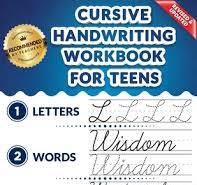 Cursive workbook
Cursive workbookMost of them use a similar format: the first section of the book revises the cursive formation of each letter - just revise and practice until your teen knows the letter.
The second section of the book usually provides words and quotes around the theme, to give your teen lots of practice in cursive handwriting.
Frequent Breaks
If your child tires easily or becomes distracted, then let them have a quick, focused break instead of plowing through and risking having their handwriting deteriorate further.
Try to avoid screen use though!
A good use of a break time would be to do some gross motor exercises (especially shoulder exercises), fine motor exercises, or getting some water to drink.
You could also try some brain breaks specifically designed for the classroom. These can help spark your child to focus on handwriting after a quick, active break.
Pick Your Battles
Sit down with your child and decide together which subjects/occasions can get away with poor handwriting and which ones absolutely have to be good.
On tasks where creative input is
being rated, your child may be able to write more freely and easily if it is not essential to be neat. Being allowed to type or scrawl at first may get the
creative juices flowing. Accept
that legible can be good enough for these times! The final submission can be neatly written, but allow messy writing in the creative phase.
It is tiring to write neatly, but if it is not required at every lesson and on every occasion, then it is easier to write neatly when it really does matter.
Figure A Work-Around
You can also consider being a scribe for your child if you are homeschooling, or consider asking for a facilitator in the school system.
When your child is brainstorming a topic, or planning answers and structure for a project, it can really help to have someone else jot down those thoughts and answers as they flow out. Once the scribe has the rough draft on paper, your child can then refine it and write it out neatly, without being tired from the initial handwriting effort.
Learning keyboarding skills has helped many children who struggle with poor handwriting - see what your child's school will allow in terms of typed essays and assignments.
Some more food for thought...
When an older child is referred for handwriting issues, my first recommendation is that we first think about WHY the handwriting is so lousy.
- Has your child always had a poor pencil
grip and weak fine motor skills?
- Are any of the other underlying skills weak?
- Or is handwriting poor because your child rushes through it?
If your child always rushes, then motivation may be more of an issue than fine motor delays.
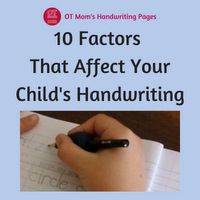 Factors impacting handwriting
Factors impacting handwritingIf your child is always rushing writing tasks, what is the reason behind it?
- distractability and poor concentration?
- A general dislike of schoolwork, boredom with that particular topic or a need to finish quickly to move on to the next activity?
If your child can write neatly on occasion, what is it that motivates them?
Answering these questions honestly could help you unlock some keys to help your older child improve handwriting skills.
You may also find it helpful to know 10 of the biggest issues that can influence a child's handwriting.
One motivation for better handwriting is to use your child’s dream vocation to inspire and encourage – I tell my son that if he wants to be an airplane pilot, he has to make sure his figures (numbers) are legible, otherwise he will end up at the wrong coordinate on the map!
I hope you found the tips and resources on this page to be helpful!
Please do not hesitate to get an occupational therapy evaluation if you are concerned about your child falling behind owing to handwriting issues.
- Home Page
- Handwriting for Kids
- Handwriting Tips for Older Kids
Share this page to help others!
Didn't find what you were looking for? Try a search of my site!
